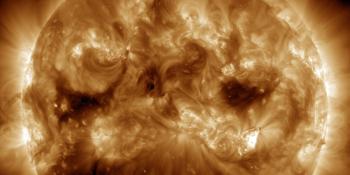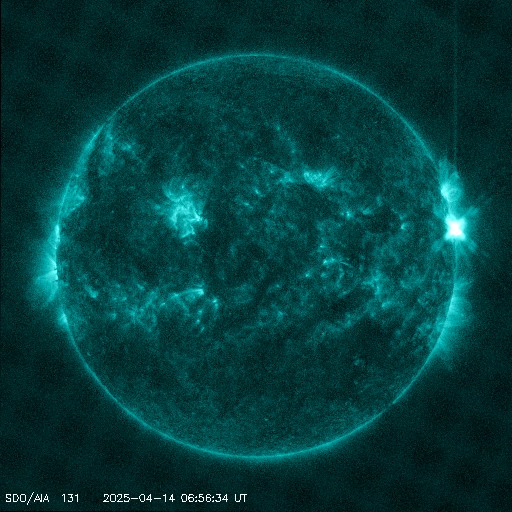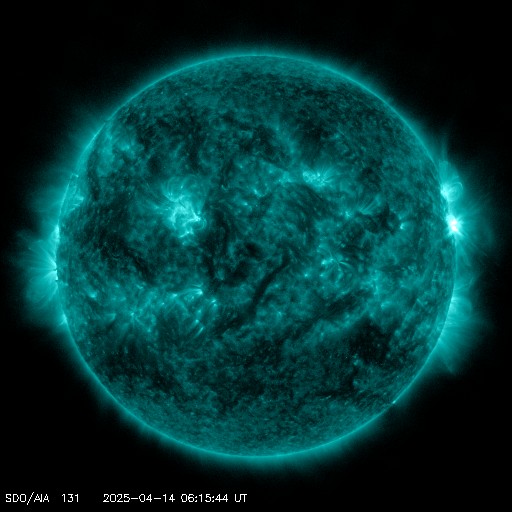Viewing archive of Wednesday, 7 September 2005
Solar activity report
Any mentioned solar flare in this report has a scaling factor applied by the Space Weather Prediction Center (SWPC). Because of the SWPC scaling factor, solar flares are reported as 42% smaller than for the science quality data. The scaling factor has been removed from our archived solar flare data to reflect the true physical units.
Report of Solar-Geophysical Activity 2005 Sep 07 2204 UTCPrepared by the NOAA © SWPC and processed by SpaceWeatherLive.com
Joint USAF/NOAA Report of Solar and Geophysical Activity
SDF Number 250 Issued at 2200Z on 07 Sep 2005IA. Analysis of Solar Active Regions and Activity from 06-2100Z to 07-2100Z
Solar activity increased to high levels this period as
newly numbered Region 808 (S12E83) produced one of the largest solar
flares of Cycle 23. An X17/3b white light flare erupted in this
region at 07/1740Z. A large and fast CME was visible on the MK4
coronagraph at Mauna Loa. Intense centimetric radio bursts
accompanied this flare, including a 27,000 sfu Tenflare. Type II
(1860 km/s) and Type IV radio sweeps were also observed. This region
also produced a very long duration M1 flare, which peaked at
06/2202Z. A fast and bright CME (1400 km/s) on LASCO imagery was
observed with this event. The sunspot cluster associated with Region
808 is just now rotating into view, so an accurate assessment of
its true size and complexity will have to wait. Region 808 is the
return of old Region 798, which produced significant solar and
geophysical activity during its last passage on the visible disk.
IB. Solar Activity Forecast
Solar activity is expected to be
moderate to high. Region 808 is obviously a complex and
moderate-large size sunspot group with great flare potential. Expect
further major flares.
IIA. Geophysical Activity Summary 06-2100Z to 07-2100Z
The geomagnetic field was quiet to active. Today's powerful X17 flare
produced a sudden disturbance in the geomagnetic field at 07/1725Z.
This 82 nT magnetic crochet was one of the largest observed this
Solar Cycle. A slow rise in the greater than 10 MeV protons at
geosynchronous orbit began near issue time. The greater than 2 MeV
electron flux at geosynchronous orbit reached high levels again
today.
IIB. Geophysical Activity Forecast
The geomagnetic field is
expected to continue at quiet to unsettled levels with isolated
active periods. The CME activity associated with yesterday's
long-duration M1 and today's X17 flares were not Earth directed. The
greater than 10 MeV protons at geosynchronous orbit are slowly
rising now and are expected to continue to do so. These protons will
likely cross the 10 pfu threshold on 08 Sep.
III. Event Probabilities 08 Sep to 10 Sep
| Class M | 70% | 75% | 75% |
| Class X | 30% | 30% | 30% |
| Proton | 60% | 50% | 40% |
| PCAF | yellow | ||
IV. Penticton 10.7 cm Flux
Observed 07 Sep 100 Predicted 08 Sep-10 Sep 110/120/120 90 Day Mean 07 Sep 091
V. Geomagnetic A Indices
Observed Afr/Ap 06 Sep 006/009 Estimated Afr/Ap 07 Sep 010/010 Predicted Afr/Ap 08 Sep-10 Sep 008/012-010/015-005/010
VI. Geomagnetic Activity Probabilities 08 Sep to 10 Sep
| A. Middle Latitudes | |||
|---|---|---|---|
| Active | 20% | 20% | 15% |
| Minor storm | 05% | 05% | 05% |
| Major-severe storm | 01% | 01% | 01% |
| B. High Latitudes | |||
|---|---|---|---|
| Active | 25% | 25% | 20% |
| Minor storm | 10% | 10% | 05% |
| Major-severe storm | 01% | 01% | 01% |
All times in UTC
Current data suggests there is a slight possibility for aurora to appear at the following high latitude regions in the near future
TórshavnOulu, Rovaniemi
Reykjavik
Trondheim
Luleå
Latest news
Latest forum messages
2025/04/12-13 Filament CMEs 2025/04/16 G2 Watch 38Incoming & Unnumbered Active Regions 1700Unspecified geomagnetic activity 2258AR 4055 98Potential AR4062 8
More topicsSupport SpaceWeatherLive.com!
A lot of people come to SpaceWeatherLive to follow the Sun's activity or if there is aurora to be seen, but with more traffic comes higher server costs. Consider a donation if you enjoy SpaceWeatherLive so we can keep the website online!

Latest alerts
23:15 UTC - Geomagnetic activity
Active geomagnetic conditions (Kp4) Threshold Reached: 23:01 UTC
07:09 UTC - Solar flare
Moderate M4.28 flare from sunspot region 4055
06:48 UTC - Radio Blackout
Minor R1 radio blackout in progress (≥M1 - current: M1.53)
06:24 UTC - Solar flare
Moderate M1.49 flare from sunspot region 4055
06:06 UTC - Radio Blackout
Minor R1 radio blackout in progress (≥M1 - current: M1.16)
Space weather facts
| Last X-flare | 2025/03/28 | X1.1 |
| Last M-flare | 2025/04/14 | M4.2 |
| Last geomagnetic storm | 2025/04/06 | Kp5 (G1) |
| Spotless days | |
|---|---|
| Last spotless day | 2022/06/08 |
| Monthly mean Sunspot Number | |
|---|---|
| March 2025 | 134.2 -20.4 |
| April 2025 | 132.1 -2.1 |
| Last 30 days | 130.6 -13.6 |





